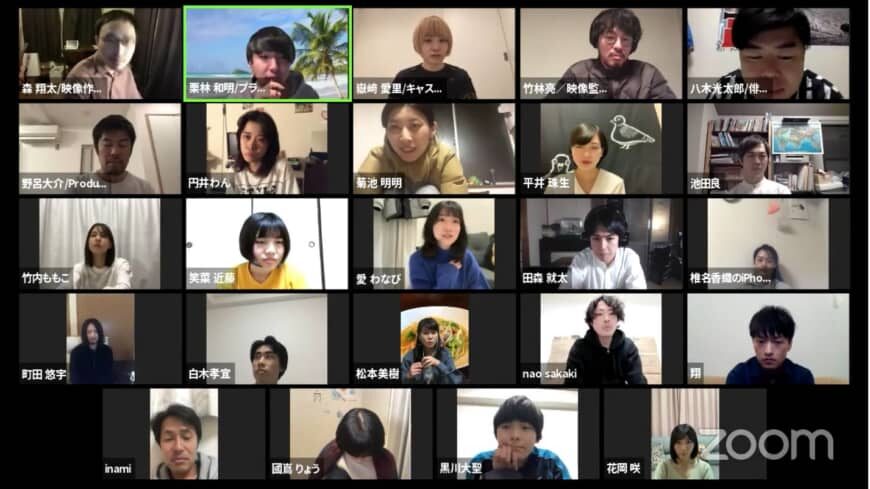Troupes turn to telework in a bid to keep audiences entertained
The performing arts are built on interactions between live audiences and artists — whether ballet dancers, circus performers, actors, or whoever else — that help to create a magical extra dimension for both. So how, faced with COVID-19 and calls for social distancing, can theater deal with the current situation?
Even before Prime Minister Shinzo Abe’s April 11 call for “self-restraint” when it came to nightlife — citing the risk of gathering in packed, poorly ventilated areas — many in the theater world had already realized that business, as usual, was no longer an option.
However, rather than counting off the days without doing anything, some troupes began experimenting with their art online.
A lot of this came in the form of posting old productions on YouTube, but slowly online script reads came into play, several actors and dancers started to teach their crafts, and then came short performances.
The Tokyo-based Chocolate company — a flourishing startup that generates online content in the form of music videos, animation, and computer games — was quick to respond to live theater’s shutdown by launching the Gekidan Telework troupe to create performances using Zoom that is then uploaded to YouTube.
“At the end of March, some Chocolate staff, all working from home, had a Zoom meeting to discuss the feasibility of starting this online theater and making it a paying proposition,” says 32-year-old Kazuaki Kuribayashi, the main planner behind Gekidan Telework. “Though I had no theater experience, after speaking with colleagues who did, we agreed to use Zoom as it has some very useful and handy functions such as real-time streaming on YouTube, which we thought would be something like a live performance.”
Kuribayashi says that by April 2 the group was inviting actors to take part in Zoom auditions that Gekidan Telework streamed as its maiden online theater offering. Three days later, the company presented its first real drama, an hour-long pilot titled “ZOOM Konkatsu Pati,” which roughly translates to “Zoom Blind Date Party.”
“It was a great opportunity for performers who hadn’t been able to work for at least a month,” says Kotaro Yagi, one of Gekidan Telework’s main actors. “I think the novel idea of streaming actual auditions was exciting for everyone, especially our audiences.”
Kuribayashi says about 1,000 people watched live while more than 8,000 caught it afterward on YouTube.
“The advantage of this style is that people can join the performance simultaneously by using YouTube’s chat function to post their reactions on screen,” he says. “Afterward, we took it another step further in the next program and let the actors read people’s comments live on-screen so they could improvise changes to the story in response. We also gave audiences the chance to choose the storyline at some points from two onscreen options we provided. Consequently, lots of viewers got absorbed in the story through being able to contribute creatively themselves.”
“It’s a real pleasure to watch live streams of these works and many viewers of the archived videos have said they regret missing (the live performances) because being able to participate in the edginess of Zoom theater makes it so different from regular recorded and edited videos or movies,” says Shota Mori, another of Gekidan Telework’s main actors and scriptwriters. “Now, of course, I’ve realized that such real-time experiences are similar to live theater because they can capture some of that magic in a different way. But, as yet, it’s difficult to express physical movements with the same immediacy as on stage. However, I think Zoom theater is set to become a new form in its own right.”
As Kuribayashi sees it, the coronavirus pandemic may actually lead to a real, widespread change in people’s preconceptions about theater by allowing new audiences to experience Zoom theater from anywhere in the world. As a result, he believes there will be lots of new hybrid forms of expression combining online and live stages, post-pandemic.
As for this venture’s bottom line, Gekidan Telework has opted to finance the initiative by asking online viewers to pay what they want — and typically around 10 percent of them contribute monetarily.
“From here on, I feel we need to cultivate new audiences by collaborating with non-theater creators such as YouTubers and voice actors, and by getting two-dimensional anime and game characters on screen,” Kuribayashi says. “Overall, though this virus is a crisis for so many, it’s an opportunity to pioneer a new, more spontaneous kind of interactive entertainment that’s not just about theater, but also music and comedy.”
Meanwhile, showing that rapid-fire innovation isn’t the sole preserve of the young, Show Ryuzanji, the 72-year-old founder of the internationally acclaimed Ryuzanji Company, and current chair of the Japan Directors Association is also busy with new online projects.
For one of these, he enlisted 12 leading playwrights across a wide range of ages — among them are Keralino Sandrovich, Nobuaki Nakamura, Roba Shimori, and Tetsu Yamazaki — and asked them to write short plays about COVID-19. Soon, when he’s learned his lines, he’ll put solo performances of the 12 works on YouTube.
“After the shutdown, I read some of my favorite books and plays online. Then my staff urged me to do more, and that led to this plan to present vivid drama dispatches by top playwrights about today’s circumstances. Now, with others all over Japan also searching out what to do, I really believe the future of theater is going to be very exciting,” Ryuzanji says. “Anyhow, I think we’ll need to coexist with this virus, or others, for a long time to come. Hence this is a great opportunity for people to rethink their priorities — whether art or economic growth — and as long as a certain number of people say they need art, then theater will survive.”
Ryuzanji shares an experience he and his company had in Indonesia in early March. There, when three separate indoor performances were canceled because of coronavirus concerns, they instead performed in temporary open-air “theaters” — one of them a shack that villagers, who became their audience, helped them to build. And, despite the disruption, all the shows were great successes.
“That wonderful interaction made me realize we don’t really need an imposing theater, and we can simply put up a tent in an open space like they did in ancient times,” Ryuzanji says. “In fact, once theater became confined inside buildings, I think it became too comfortable and safe, which weakened its power. So now we are ready to go out to wherever our audiences are, and I think in that way theater will be more integral to their lives.”
Whatever the roadmap ahead turns out to be, it appears that efforts to overcome COVID-19 are helping put wheels in motion that could take Japanese theater in exciting new directions.
For more information on Gekidan Telework, visit https://twitter.com/gekitele
For more information about Ryuzanji Company, visit www.ryuzanji.com
This article was originally posted at The Japan Times and has been reposted with permission. To read the original article, click here.
This post was written by the author in their personal capacity.The opinions expressed in this article are the author’s own and do not reflect the view of The Theatre Times, their staff or collaborators.
This post was written by Nobuko Tanaka.
The views expressed here belong to the author and do not necessarily reflect our views and opinions.


















